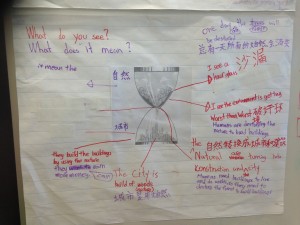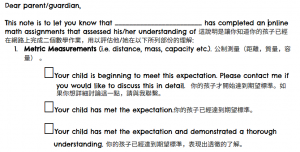I have always known that I wanted to be a teacher. I’m not exactly sure when to pinpoint the start of my journey, but from as young as five years old, I knew that teaching was my calling. Throughout my educational career I had some amazing teachers who provided me with invigorating learning experiences that were creative, challenging and fun. I also encountered “the other guys”. Needless to say, I’m sure my experiences aren’t unique to those who have encountered a public education in Ontario over the past thirty years. Although I can bashfully say that I don’t remember most of what I learned from my ten years of elementary school, even as an enthusiastic and engaged learner, the two resounding life lessons that I continue to embrace are: to never settle for mediocrity and to always go beyond the call of duty. Thanks to my grade 7 and 8 teachers, I continue to strive to apply these key learnings in my life.
As I reflect on my key learnings, I wonder what key learnings I might share with my students. The experience of school in the 21st century is so much different than being a student in the 80s and 90s. The over emphasis on consumerism, the pervasiveness of social inequities and the advancements of technology which birthed the unvaulted access to information definitely add layers to make the schooling experience even more dynamic than when I was a child. How did my teachers prepare me for my future? How might I prepare students for theirs? These are essential questions I continue to grapple with and is the essence of what the heart of teaching is for me.
I believe that at the heart of teaching is the desire to help students be the best version of themselves so that they can be contributing members of society. This may seem like a long-term goal but really, at its core is my desire to prepare students to be their best self now, in order to continue to be their best self in the future. Teaching the curriculum definitely addresses many of the content that students need to know in order to achieve success in their future academic and social experiences. But what might be absent from the curriculum that proves to be essential life lessons that students might benefit from having guidance over? Throughout the past 7 years I have come to realize that more than the curriculum, there are essential life lessons students need to be exposed to. Supporting students as people first and learners second is how we can help them navigate some of the challenges they face in their day to day experiences of schooling. It is not just about the curriculum. We need to reach both the student’s heart and their mind.
Everyday I am constantly wondering about how my students are navigating the world while I address curriculum expectations. These are the reflective questions that arise from my interactions with them:
- How might we support my students in seeing themselves as capable?
- How might we support my students to be motivated from within themselves and not based on grades or the need for validation?
- How might we encourage my students to take risks and try new things when realistically when we evaluate their understanding of curriculum and the consequences of risk taking may not garnish the reward they desired?
- How might we teach the value of perseverance and that dedication to a task may cause improvement and denounce the rhetoric that practice make perfect.
- How might we support my students in navigating the social hierarchies in school knowing that creating a respectful learning environment does not guarantee the kind of friend relationships that students are looking for from their peers?
- How might we support my students in navigating a competitive world while yet embracing the benchmark of their own personal best?
- How might we support my students in navigating the reality that particular aspects of their social identities (race, accents, culture, etc.) will grant them access into some opportunities but also bar them from others simply because of the ways societal systems are structured and not necessarily based on personal attacks?
- How might we nurture confidence in our students?
- How might we make students accountable for their choices?
- How might we support students in embracing self-love in a society that values constant validation from others?
- How might we support to identify their emotions beyond happy, mad and sad and how to effectively navigate them?
Like many of the questions that I pose, I don’t always have the answers. As I continue to reflect deeply, I can only hope that my pedagogical choices can address some of these concerns. As I teach to the minds of my students, what I hope for is to reach their hearts. Teaching from my heart, I pull back the curtains of curriculum and instruction and see the person and not just the learner. This unveils the weight of the task set before me.











 does not get enough attention. I’m talking about mental health in schools.
does not get enough attention. I’m talking about mental health in schools.